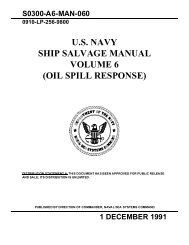FACEPLATE FNL (April 2004) - Supervisor of Salvage and Diving
FACEPLATE FNL (April 2004) - Supervisor of Salvage and Diving
FACEPLATE FNL (April 2004) - Supervisor of Salvage and Diving
Create successful ePaper yourself
Turn your PDF publications into a flip-book with our unique Google optimized e-Paper software.
(Building a Warship... continued from page 11.)<br />
The Christening Ceremony!<br />
world. Only two shipyards in the United<br />
States have the capacity <strong>and</strong> workforce<br />
capable <strong>of</strong> the task. At Bath Iron Works, a<br />
large sign sits over the main entrance to<br />
the shipyard, “Through these gates pass<br />
the finest shipbuilders in the world.”<br />
It is not just a sign; it is a work ethic evident<br />
in every facet <strong>of</strong> the company. The shipbuilding<br />
process begins with the 6,200 tons<br />
<strong>of</strong> steel <strong>and</strong> 406,000 pounds <strong>of</strong> welding rods.<br />
Forty-eight miles <strong>of</strong> pipe <strong>and</strong> 254 miles <strong>of</strong><br />
electrical cable are installed, all by h<strong>and</strong>!<br />
Three hundred <strong>and</strong> fifty-seven doors/<br />
hatches/scuttles, 6,500 light fixtures,<br />
8,000 valves, <strong>and</strong> 69,000 gallons <strong>of</strong><br />
paint complete the process. Each<br />
step worked with meticulous attention to<br />
detail befitting BIW’s other slogan, “Bath<br />
built is best built!”<br />
Evelyn Momsen Hailey breaks champagne bottle on the<br />
hull <strong>of</strong> USS MOMSEN.<br />
As the shipyard<br />
pressed on with its construction<br />
schedule, so did<br />
the crew. Well-trained<br />
individuals were forged<br />
into efficient teams through<br />
L<strong>and</strong> Based Engineering<br />
Simulators in Philadelphia,<br />
Combat Information Center<br />
Team Training in Wallops<br />
Isl<strong>and</strong>, Virginia <strong>and</strong><br />
innovative Fire Fighting<br />
Team Training in Newport,<br />
Rhode Isl<strong>and</strong> <strong>and</strong> Bath,<br />
Maine. By March <strong>of</strong><br />
<strong>2004</strong>, MOMSEN was 98%<br />
complete <strong>and</strong> ready<br />
for sea trials. Just<br />
four days at sea<br />
were needed to test<br />
every major system,<br />
fire two st<strong>and</strong>ard<br />
missiles, the 5-inch<br />
62 caliber gun, run<br />
the engineering<br />
plant up to full<br />
power, <strong>and</strong> complete<br />
hundreds <strong>of</strong> other<br />
system tests. The<br />
ship performed<br />
magnificently <strong>and</strong><br />
even had the<br />
opportunity to<br />
display good seakeeping<br />
ability<br />
when some New Engl<strong>and</strong> weather<br />
rolled through the Gulf<br />
<strong>of</strong> Maine!<br />
In May, the crew<br />
had grown to 290, 70%<br />
<strong>of</strong> whom had never<br />
served a tour <strong>of</strong> duty<br />
aboard ship. Production<br />
was 100% complete <strong>and</strong><br />
on May 6, <strong>2004</strong>, the<br />
Navy <strong>of</strong>ficially accepted<br />
MOMSEN in a brief but<br />
important Ship Custody<br />
Transfer Ceremony.<br />
The ship now belonged<br />
to the Navy <strong>and</strong> the<br />
crew was charged<br />
with its maintenance,<br />
training, <strong>and</strong> upkeep.<br />
All the functions necessary to support a<br />
shipboard routine started that day. The<br />
crew moved aboard, ate their first galley<br />
prepared meal, <strong>and</strong> stood the first set <strong>of</strong><br />
shipboard watches.<br />
At the end <strong>of</strong> July, MOMSEN will sail<br />
down the Kennebec River <strong>and</strong> start the<br />
transit to her homeport, Everett,<br />
Washington. At the end <strong>of</strong> August, the<br />
Commissioning Ceremony will be held in<br />
Panama City, Florida. It is fitting that the<br />
ship named after the father <strong>of</strong> Navy diving<br />
will be commissioned in the home <strong>of</strong> Navy<br />
diving <strong>and</strong> salvage.<br />
In the early part <strong>of</strong> the twentieth<br />
century, Charles “Swede” Momsen started<br />
CDR Ed Kenyon, Comm<strong>and</strong>ing Officer, <strong>and</strong> LCDR Bill Bullard,<br />
Executive Officer, on an icy bridge wing during sea trials.<br />
a legacy that lives through Navy Divers -<br />
past, present, <strong>and</strong> future. USS MOMSEN<br />
will bring the Momsen legacy to a new<br />
generation <strong>of</strong> Sailors not involved with<br />
diving or salvage <strong>and</strong> well into the twentyfirst<br />
century.<br />
The life cycle <strong>of</strong> a warship<br />
is thirty years. During that time, 3,500<br />
Sailors will cross the brow <strong>and</strong><br />
call MOMSEN “their ship.”<br />
The commissioning crew <strong>of</strong><br />
MOMSEN welcomes all Divers into this<br />
new fraternity <strong>and</strong> hopes Navy Divers<br />
everywhere consider USS MOMSEN<br />
“their ship”, too.<br />
This article was written by the<br />
Pre-Commissioning Crew <strong>of</strong> USS<br />
MOMSEN (DDG 92).<br />
1 4 A u g u s t 2 0 0 4

















